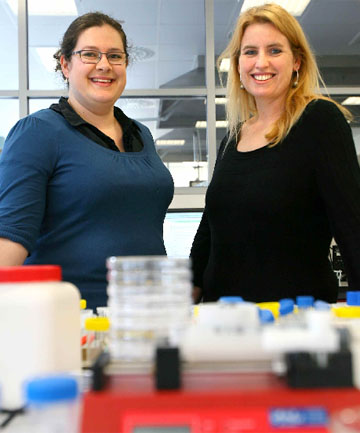Implant project proves winner

McGrath, the Director of the MacDiarmid Institute, Victoria University lecturer and Wellingtonian Of The Year Science & Technology finalist, has been working to create a material for implants that is more closely modelled to human and animal bones and teeth.
Victoria University chemistry professor Kate McGrath has been awarded $50,000 from economic development agency Grow Wellington to further her research into creating lighter and more durable joint replacements.
Her submission to Grow Wellington's 2012 Innovating for Health Challenge on hard tissue implant technologies with research assistant Natasha Munro was named Lead Innovation of the Year.
"It would be awesome if we could start to replace metal-based implant systems such as hip replacements. We've been making a material that is made from the chemical basis of native bones and teeth and so we're trying to generate something that has complete chemical compatibility," McGrath said.
Metal implants were popular worldwide because of their strong mechanical characteristics but typically knee and hip replacements had a lifespan of only about 15 years and tended to wear down and damage the surrounding joint tissue, making it harder to fit the second implant.
With a material similar to human bones, implants would probably have lower rejection rates.
"From a chemical and biochemical point of view, metal replacements are nothing like the native system. They are also very very dense, so you get great strength and durability but you have to carry around something much heavier.
"Our long-term aim is to produce something that has all the chemical, biochemical and mechanical characteristics that are equivalent to the native system."
So far their research has resulted in a film that has all the biochemical characteristics that a 3-D implant such as a false tooth or hip replacement would need. The $50,000 funding would be used to create a prototype of the film material in a 3-D format to first be used to make dental fillings for cows. Once that step is achieved it would be proof of concept that the material could be used more widely in human dental care and as bone implants for humans and animals.
Grow Wellington's panel of experts from the Business, Innovation and Employment Ministry, the biotech industry, health services research, an industry entrepreneur and investor found McGrath's work had a depth of the science and commercial potential.
Grow Wellington head of science and technology Adrian Gregory said Wellington had the highest level of research scientists per head in New Zealand.
"[That] gives us enormous potential for developing world-class medical solutions for multibillion- dollar global markets."
Jazial Crossley, Dominion Post, 28/11/2012. Image credit: Matt Duncan/Fairfax NZ
